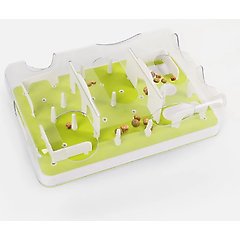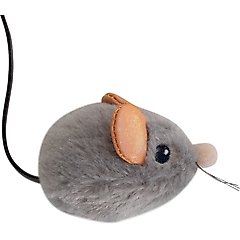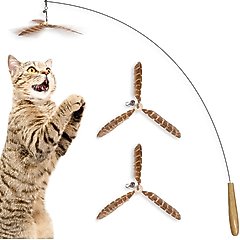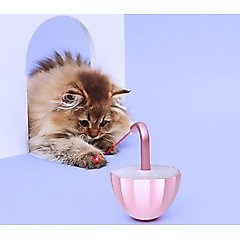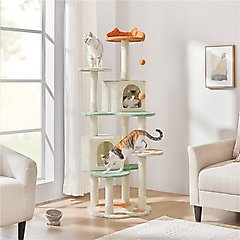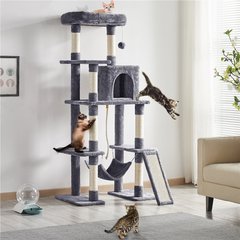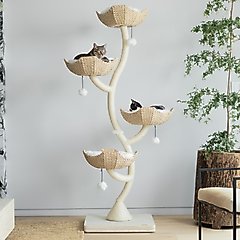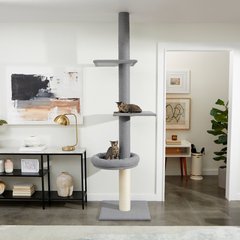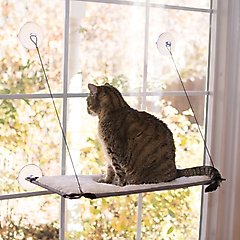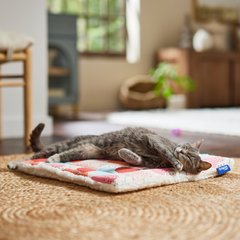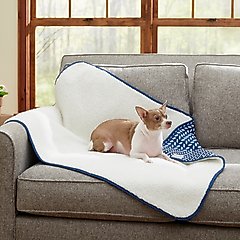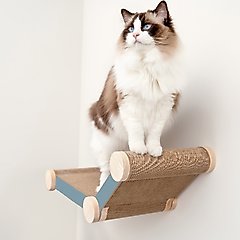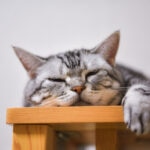Do Cats Always Land on Their Feet?
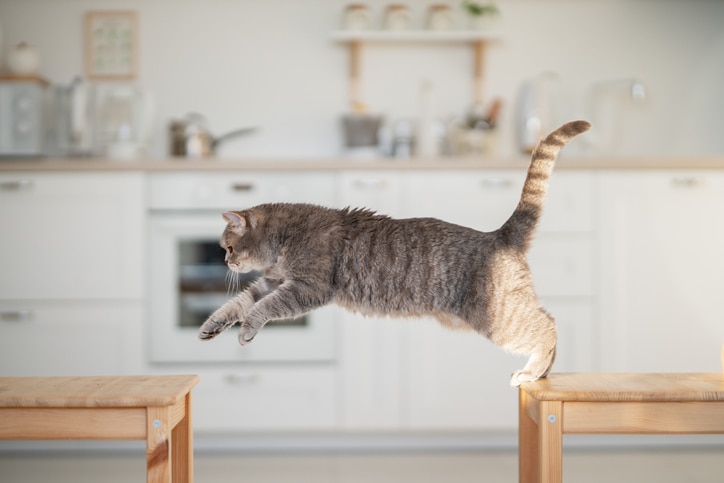
Photo by Anmfoto/iStock/Getty Images Plus
Cats share a remarkable ability to twist their bodies midair and land on their feet. It’s a skill known as the “righting reflex,” and it helps cats survive falls from great heights.
But do cats always land on their feet? No, not always. While the maneuver is impressive, it’s not foolproof—and not always without injury.
“I’d say it’s about 50/50 for cats landing on their feet,” says licensed veterinary technician Ellen Carozza. Interestingly, the higher the fall, the better their chances of successfully landing feet-first, because it gives them more time to twist their position and slow their fall, adds Wendy Davies, a veterinary rehabilitation technician at the University of Florida Small Animal Hospital.
Key Takeaways:
- Cats don’t always land on their feet, but it’s not unusual for them to have a perfect landing.
- Felines have an innate skill called the “righting reflex” that helps them orient themselves.
- Generally, their righting reflex makes them more likely to land safely if they fall from a greater height.
Why Do Cats Land on Their Feet?
You’ve probably heard that cats have nine lives, and stories of felines surviving falls from high-rise buildings do anything but squander the tale. But the secret behind these miraculous survival stories isn’t extra lives—or even luck. It’s physics, flexibility, and an extraordinary innate skill called the “righting reflex.”
It’s due to the following extraordinary features of cats that make it all possible.
Strong Muscles
“When they fall, cats first position their head, then their front legs, and finally the hind legs, using quick muscle coordination and flexibility in the spine to twirl without violating the laws of physics,” explains Lucy Miller, a veterinary physiotherapist and founder of Step Ahead Veterinary Physiotherapy. That skillful positioning requires incredible strength—something even the average housecat has.
According to Miller, cats have an impressive muscle-to-body ratio, especially compared with humans. Their bodies are built for speed and agility, packed with fast-twitch muscle fibers that fire rapidly for powerful bursts of movement.
As a cat falls, they activate muscles across the back, shoulders, core, and limbs. Their muscular physique provides the explosive power needed to reposition midair. At the same time, strong abdominal muscles help steady and brace the body before touching down.
Skeletal Structure
Cats are often called liquid for a reason—they seem to defy the laws of physics. And when it comes to their uncanny ability to land on their feet, there’s no lack of liquid-like contortion.
“Cats will bend themselves in the middle and rotate the front half of their body on a different axis than their back half,” Davies explains. In less than a second, they sense their positioning in midair and twist up to 90 degrees to face the ground.
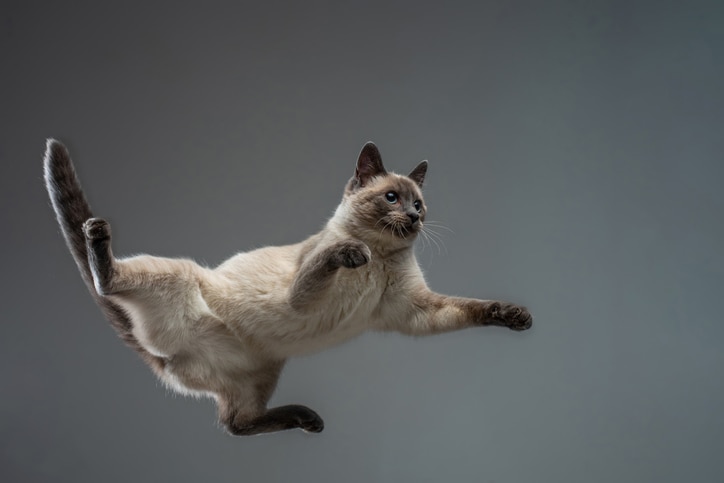
Photo by VladK213/iStock/Getty Images Plus
“Cats have a very lightweight and stretchy skeleton, which is a great advantage when falling,” Miller says. There are more vertebrae in their spines than most other animals, especially in the back and tail, giving them incredible flexibility.
Also, their clavicles, or collarbones, float freely, she notes. Instead of being attached to other bones like in humans, a cat’s collarbone is connected by muscle, which gives them a longer stride, lets them slip through tight spaces, and allows for a greater range of motion.
That flexibility also allows their front legs to better absorb the impact upon landing, Davies adds.
A Fluffy Coat
A cat’s coat isn’t just for looks; it plays a functional role in keeping them protected from the sun, rain, and temperature changes. But here’s something surprising: That floofy fur can also help cats safely land after a jump or fall. “Their fur helps by providing drag to slow terminal velocity,” Davies says.
Low Body Weight
According to Miller, a cat’s relatively small body weight and compact, muscular build help reduce their terminal velocity compared with larger animals. This slower fall can make it easier for them to absorb the impact and land safely.
Why Might a Cat Not Land on Their Feet?
The righting reflex is remarkable, but as Miller says, “Cats are not invincible.” If a cat doesn’t have enough time or height to adjust its body in midair, or if they’re caught off guard, they may not land properly. Even a well-executed landing can result in injury.
Here are a few factors that can affect your cat’s chances of successfully landing on their feet.
Age
You’re not the only one who gets a little stiffer with age—cats do too. Even before they hit their senior years around age 10, many start to experience joint stiffness or arthritis that can make midair twists more difficult. Aging cats also tend to lose muscle mass and may struggle with balance. Slow, gentle daily exercise can make a big difference in keeping older cats agile and balanced, Miller says.
Simply encouraging cats to move around the house more, like using the stairs, counts as daily exercise, says Dr. Teresa Manucy, DVM, a pet health representative for Chewy.
‘Place the food bowl in an out-of-the-way location so they will put some effort into getting their meals,” she says. Toys that allow cats to “hunt” for their food may also encourage movement, she notes.
Recommended Product
But exercise doesn’t have to be food–motivated. “Toss a ‘mouse’ down the hall or purchase a kitty ‘fishing pole’ or laser pointer to get them moving,” Dr. Manucy says.
Recommended Products
Weight
Chonky cats might look cute, but carrying extra weight isn’t fun. “Being overweight is really bad for their health in a number of different ways,” Davies says, noting that an increased risk of injury from a fall is just one concern. “Fat equals inflammation, and inflammation can cause pain, which can make them less able and likely to move.”
Health
Any injury or disease that lowers muscle strength, flexibility, or coordination is going to make the righting reflex more difficult. Examples include missing a limb, hip dysplasia, and cerebellar hypoplasia.
Cats rely on their inner ear’s vestibular system to pull off the righting reflex—it’s what helps them sense balance and figure out which way is up and down, Miller explains.
So what about deaf cats? They’re just as likely to land on their feet as a hearing cat. That’s because most genetic deafness affects the hearing part of the inner ear, not the balance part.
Height
“Ironically, the higher a cat falls from, the greater chance of surviving,” Davies says. That’s because a greater height gives the cat more time to recognize where they are in space, twist into position, and slow their fall.
So what’s the sweet spot? While any fall can be dangerous, a study of 132 cats who fell from two or more stories found that those who fell from seven stories or higher actually had fewer injuries.
Still, “just because a cat can right itself doesn’t mean they won’t be injured,” Davies cautions. Of the cats studied for what’s known as “high-rise syndrome,” 90% survived—but 37% required life-saving treatment. Nearly all of them—about 90%—suffered injuries to the chest, lungs, ribs, or heart.
When it comes to jumping, Miller says that healthy cats are usually fine leaping from heights of five or six feet indoors, like a counter or cat tree. Anything higher warrants caution and a soft landing area.
Recommended Products
Surface
Landing on a soft surface can lessen a cat’s odds of being injured from a fall or jump. In the study above, researchers found that mud, snow, and water reduced the severity of injuries when compared with hard surfaces.
Breed
Carozza and Miller point out that some cat breeds, like Abyssinians or Bengals, tend to be more agile and muscular than stockier, less athletic breeds, such as Persians or Scottish Folds. That said, they agree: All healthy cats are capable of performing the righting reflex. And physical fitness matters more than breed.
How to Prevent Your Cat From Falling
Carozza says that nearly every one of her patients fell while walking along a railing or squeezing between balcony bars. Those injuries, says Miller, are some of the most preventable.
“The best safety measure if you have a balcony is to not allow your cat access unless it’s been made cat-safe,” Carozza says. That means no gaps between bars, no access to railings, and no weak netting or wire that a cat could break through. For windows, make sure they’re closed or fitted with secure screens that can’t be pushed out.
You can also set up your home to satisfy your cat’s climbing instincts without putting them at risk. Offer stable cat trees, wall shelves with nonslip surfaces, and soft landing zones like cushions or mats. Window perches must be secure, and screened patios or “catios” should be reinforced. Lastly, avoid clutter on high shelves, which even agile cats can trip over.
Recommended Products
FAQs About Do Cats Land on Their Feet
Q: Can cats survive a fall from any height?
A: “There’s no “safe” height for a cat to fall from,” Davies says. Even a jump from a countertop can lead to injury. While greater heights may give cats enough time to “right” themselves midair, that doesn’t guarantee a safe landing.
Q: At what age do kittens learn to land on their feet?
A: “The righting reflex typically begins to develop around 3 weeks of age, and kittens tend to be completely able to right themselves and land on their feet at 9 weeks,” Davies says, adding that rodents, lizards, and primates also have a similar righting reflex.
Q: Can cats land on their feet if they fall upside down?
A: Yes. According to Davies, cats can right themselves from a completely upside-down position (90 degrees) in less than a second. They tuck their front limbs to increase momentum in the front half of their body and extend their rear limbs, rotating their front half, she explains. Then they reverse the motion—extending the front limbs and tucking the rear limbs—so the back half can rotate to match.
Q: Do cats always land on their feet when falling backward?
A: Cats don’t always land on their feet, but thanks to their inner-ear balancing system and flexible bodies, they usually can. Even if a cat falls backward, their inner ear helps them sense their position in space and, if they have enough time and distance, cats can twist around to land on their feet.
